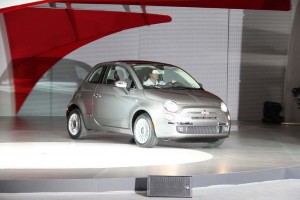
Will significant previews, like the debut of the Fiat 500, pack the public into L.A.'s Staples Center?
Want to get a read on the mood of American motorists? Head to the L.A. Auto Show, this week. The annual event has routinely offered an insight into the economy – and the mood of the motorists who quite literally drive one of the biggest sectors of the economy.
Over the last several years, the LA Auto Show reflected the arrival of a financial crisis that sank far deeper than anyone might have expected. Anyone who wondered about the financial problems plaguing Detroit only had to visit the Chrysler booth, where even the spotlights were turned off, in 2008, to save money.
But the show that just opened its doors to the public seems poised to make potential buyers forget the depressed mood of the past years. This year, the LA show is vibrant and very much alive.
In the 20 years that I have attended the show, I have never seen a larger audience during the media preview days. Significantly, the event brought not just media but plenty of industry insiders, curious to see what their competitors brought on stage.
(You could even see a number of Chinese engineers lying flat on their backs at the Nissan booth trying to take measurements on the maker’s new Quest minivan.)
Nevertheless, the international media that flew into the City of Angels arrived in larger numbers then ever. Volkswagen took German media for the unveiling of the Eos and four TDI variants that will soon power the Polo, Golf, Passat and Jetta.
Porsche also brought European journalists to the show, but for another reason: a chance to stay on for a drive of the new Porsche Carrera 911 GTS. There was also a contingent of media in tow behind Mercedes-Benz executives, who used the L.A. Auto Show as justification for a tour of the maker’s Carlsbad design studio.
Kia kept the flights from Asia filled bringing media over for the launch of the Optima Hybrid, its first gas-electric model, as well as the Pop-Up concept car. And there were plenty of reporters tagging along with the Detroit Big Three, who wanted to enter the lion’s den, a show often dominated by imports, to prove that the domestics are back in force.
Now that the show is open to the public, it will be intriguing to see what the take on this year’s event proves to be. There’s no question that the L.A. Show ramped up its increasing focus on things environmental. It will be hard for the average motorist to find a display that doesn’t make some mention of electric propulsion, even the luxury marques like Mercedes, with its F-Cell, Jaguar, with the C-X75 plug-in hybrid, or Lotus, which plans to incorporate a hybrid system developed for Formula One into the five new models it claims to be working on.
But there is more to the 2010 L.A. Auto Show than just battery power. Mazda, for one, is offering a hint into its longer-term design direction with the Shinari Concept, while Nissan provides a glimpse of its next-generation sedans – according to styling chief Shiro Nakamura – with the Ellure Concept.
And, of course, there are some classic performance machines, from the new Dodge Charger to the Mercedes CLS63 AMG, the latter a reminder that the biggest luxury market in the world is concentrated in Southern California.
But in this new era of value consciousness, perhaps one of the most significant debuts comes from Fiat, which is marking its return to the U.S., after a two-decade absence, with the launch of the little 500 microcar.
In other words: the LA Auto Show offers a diversity of cars and concepts, with gasoline engines, diesels, hybrids, electro motors and fuel cells.
No wonder there’ll be so much attention paid to the public turnout, in the days to come. If past is prologue, the way consumers respond to the show could provide some insight into not only the recovery of the U.S. auto market, but the American economy, as well.
